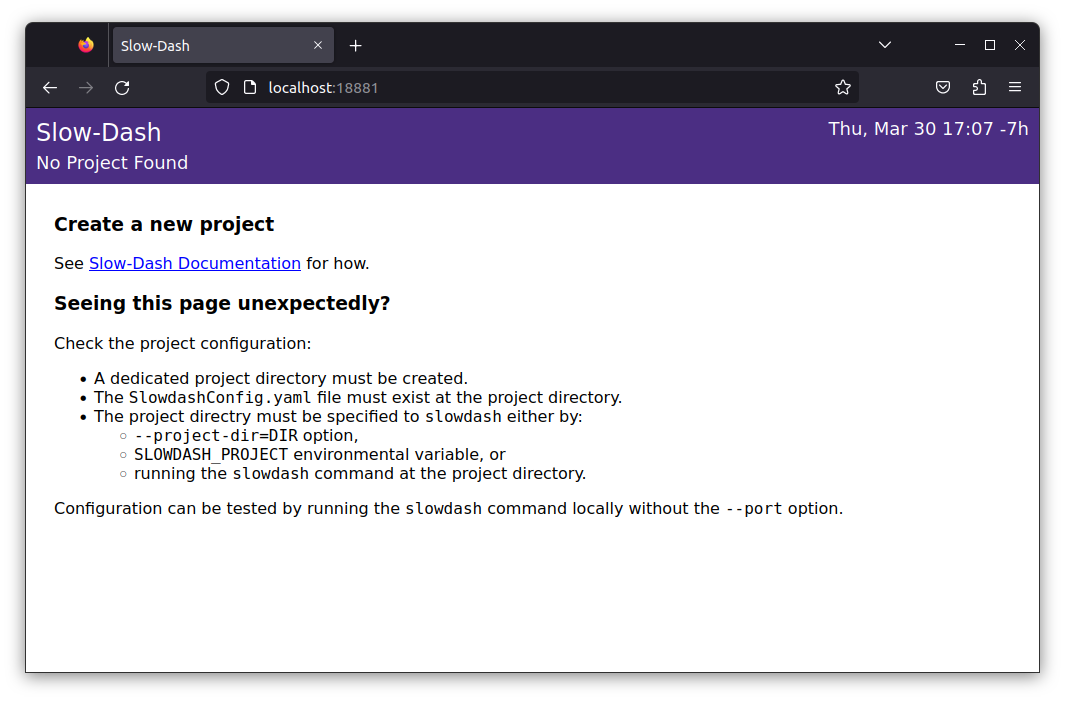
No local installation is required. Simply pull a SlowDash image from one of these official repositories:
Select either a specific version tag from the repository or use
latest for the most recent stable release.
For users of the :latest tag from DockerHub or GitHub
Container Registry, update to the newest version by running
docker pull
$ docker pull slowproj/slowdash:latest$ git clone https://github.com/slowproj/slowdash.git
$ cd slowdash
$ make dockerAlternatively, you can execute these commands manually:
$ git clone https://github.com/slowproj/slowdash.git --recurse-submodules
$ cd slowdash
$ docker build -t slowdash .
$ docker build -t slowpy-notebook -f ./lib/slowpy/Dockerfile ./lib/slowpy$ cd PATH/TO/SLOWDASH
$ make update
$ make dockerOr execute these commands manually (Important: Always include
--recurse-submodules to avoid common integration
issues):
$ cd PATH/TO/SLOWDASH
$ git pull --recurse-submodules
$ docker rmi -f slowdash slowpy-notebook
$ docker build -t slowdash .
$ docker build -t slowpy-notebook -f ./lib/slowpy/Dockerfile ./lib/slowpyThis installation method keeps all files contained within the git-cloned directory. You can completely remove the installation by deleting this directory.
$ git clone https://github.com/slowproj/slowdash.git --recurse-submodules
$ cd slowdash
$ makeThis will create a bash file to set environmental variables.
source it to include the settings:
$ source PATH/TO/SLOWDASH/bin/slowdash-bashrcThe contents of the file look like this:
export SLOWDASH_DIR=/PATH/TO/SLOWDASH
alias slowdash="$SLOWDASH_DIR/bin/slowdash"
alias slowdash-activate-venv="source $SLOWDASH_DIR/venv/bin/activate"For permanent installation, it might be convenient to include the
source command in the .bashrc (or
.zshrc on Mac) file at your home directory.
$ git clone https://github.com/slowproj/slowdash.git --recurse-submodules
$ cd slowdash
$ make without-venv
$ pip install -r requirements.txtThen activate the environment:
$ source bin/slowdash-bashrcVerify your installation by running:
$ slowdash
Running in venv at /PATH/TO/SLOWDASH/venv
usage:
Web-Server Mode: slowdash.py [Options] --port=PORT
Command-line Mode: slowdash.py [Options] COMMAND
Slowdash Version 250128 "Skykomish"
positional arguments:
COMMAND API query string. Ex) "config", "channels", "data/CHANNELS?length=LENGTH"
options:
-h, --help show this help message and exit
-p PORT, --port PORT port number for web connection; command-line mode without this option
--project-dir PROJECT_DIR
project directory (default: current dir if not specified by SLOWDASH_PROJECT environmental variable)
...Test the web interface by starting the server on a test port. You’ll see a warning about undefined project settings, which is expected at this stage:
$ slowdash --port=18881
23-05-15 20:12:35 WARNING: unable to find Slowdash Project Dir: specify it with the --project-dir option, set the SLOWDASH_PROJECT environmental variable, or run the slowdash commands at a project directory
listening at port 18881$ firefox http://localhost:18881If successful, you’ll see this configuration notice:

Press Ctrl-c to stop the server.
$ cd PATH/TO/SLOWDASH
$ make updateOr manually execute:
$ cd PATH/TO/SLOWDASH
$ git pull --recurse-submodules
$ makeRunning make is always safe, even if no updates are
needed.
After updating the SlowDash server, you may need to clear your
browser’s cached scripts. To force a cache refresh, hold down the
Shift key while clicking the reload button on any SlowDash
page (“hard refresh”: the procedure might be different depending on the
browser).